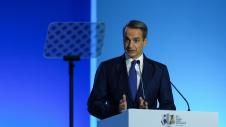Without ... banks, economic growth is picking up this year, as, despite the excessive liquidity in the banking system as the net flow of loans to businesses and households are either at low levels or, in the case of households, at negative levels.
According to the data from the Bank of Greece, in January - August 2021, the net flow of financing, ie new loans minus the repayments of older loans, to businesses was negative by 100 million euros, while at -1.1 billion euros for the net flow to households. That is, the old loans that were repaid were more than the new loans issued.
The news for business was significantly more positive in September with a net inflow of 603 million euros, while the annual rate of change fell to 3.5% from 3.7% in August. For households the change came in at -2.7%.
It is worth noting that, despite the strong real estate market, the rise in prices and significant construction activity that is underway, in the nine months, the net inflows of new loans in mortgages amounted to -1.2 billion euros. Here, too, the increased liquidity from government support programs, but also money that had been saved in previous years of extreme uncertainty, is being used to buy real estate with only a small amount coming from lending.
Bank officials say that this picture is largely cyclical due to the large repayments of old loans (such as that of PPC amounting to 600 million), the shift of companies to bond issues and the reduction of demand for loans from companies, as they have high levels of liquidity, having been strengthened by support measures, but also the recovery of their revenues this year due to the good course of the economy. They note that targets for new loans set for 2021 will be achieved, however the large loan repayments, which were not expected, are changing the broader picture.
The increased liquidity of companies is also due to significantly higher lending in 2020. According to the Bank of Greece, in 2020 the net flow of bank financing to companies amounted to 6.7 billion euros, while the gross amount exceeded 24 billion euros.
According to banks, large liquidity injections in 2020 created large liquidity cushions, not only for businesses but also for households, making borrowing unnecessary. The excess liquidity is reflected in the consumer boom that occurred this year with a large part of the 16.2% of GDP growth seen in the second quarter of 2021 coming from consumption.
In addition, bank executives point to another dimension that negatively affects corporate financing: the acquisition of companies by funds. As a rule, acquisitions of companies, such as Chipita by the US Mondelez, lead to refinancing of debt with repayments to Greek banks and the provision of liquidity from the parent group’s credit lines.
Pick up expected in 2022
According to bank estimates, 2021 was a transitional year. The partial return to normalcy, with the restoration of revenue streams, combined with the large increase in lending in 2020, resulted in companies holding on to more cash with no need for borrowing. This is estimated to change in the new year, where in addition to the increased needs created by the acceleration of the economy, the first investments financed through the Recovery Fund will be seen. Thus, the banks expect a significant acceleration of credit expansion and the flow of new loans, mainly to businesses but also to households.
YIANNIS PAPADOGIANNIS









